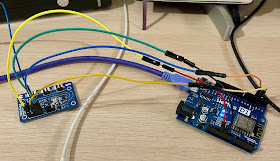Wanting to play with a simple WSPR Beacon in the house where I can't receive GPS for time synchronisation, I've hacked together a beacon using an Si5351 oscillator and an ESP8266 board that joins my Wifi and gets the time from an NTP server.
Here's the rig:
It starts off by joining Wifi, then requests the time from time.nist.gov. Next it figures out how many seconds to wait before the next 2 minute slot and delays that long. The WSPR signal is transmitted followed by a 10 second delay before requesting the time again. Assuming the NTP server replies, WSPR transmission is every second 2 minute slot.
The Si5351 generates a square wave into 5cm of wire and there's massive hum on the signal presumably due to the USB power. Here's how it looks decoding off air:
I got this going using a WeMos D1 R2 board which is basically an ESP8266 on an Arduino style board. I tried to use an ESP32 but for some reason (possibly power voltage) I couldn't get it to talk to the Si5351 although it could see it on the I2C bus.
Just a toy really but might be useful for something. The source code is here.
I'm using Arduino 1.8.15 and the following libraries are installed:
- Etherkit JTEncode 1.3.1
- Adafruit Si5351 1.2.1
- Other libraries for UDP were bundled with the board, in my case LOLIN(WeMos) D1 R1


Thanks for this Peter. I gave it a try as I had all the parts in my shack, it works great, (I think),I've never done any WSPR stuff before. I left the frequency set to what it was in your sketch, 7.038.600 which appears to be correct but it shows on the frequency counter to be 7.040 which I think is right. I need to do more research. BTW, one of the contributors to the library for this is an old friend from Portland Oregon, Jason NT7S in fact I'm using one of his Si5351A breakout boards to test with. I think I will build a small LPF and put this on the air to see if anybody hears it.
ReplyDeleteJoel
N6ALT
Thanks Joel,
ReplyDeleteMy Si5351 was a fair way off frequency so I had to tweak it to get within the band.
Great that you know Jason, he is a legend.
73
Peter
I just checked and got six spots, so it must be working!
ReplyDeleteJoel
N6ALT
Great to hear that!
ReplyDeleteThats a neat project. Could you fit this code into an ATMega328? I tried this, using Jason's JTEncode library, but couldn't make it fit memory. Just a thought! VK3HN.
ReplyDeletePaul, I will try and let you know.
ReplyDeletehi , nice project , i have a question : the time used is UTC time or time zone ? for example UTC+1 ? Thanks
ReplyDeleteTimezone isn't important as all the code looks for is the transition to the start of a new even minute.
ReplyDeleteok, thank you for your answer, by studying the functioning I realized it!
ReplyDeleteFor my first test, I was listened to at 1487 km with 10mw (on 40m), incredible. 73 and have a nice day . F4HLQ
Hello Peter,
ReplyDeletebuilt it 3 days ago and it works now with a 12m LW via 9:1 unun, best record on 15m:
2022-10-16 13:06 DH2WS 21.096060 -30 0 JO30rr 0.005W KD2OM FN12gx 6153Km !
73 to downunder, Wolfang, DH2WS
Nice little project.
ReplyDeleteI lashed this up on some Vero style material and later had a PCB made for the project. A bit of overkill perhaps but I was getting some other PCB's made so why not.
Here's a link to my project:-
http://www.carnut.info/WSPR_Tx/ESP8266/ESP8266_WSPR.html
Glenn
vk3pe
I'm a total newbie. Can Compile the code using Windows 11 Visual Studio Code? If so, How?
ReplyDeleteThanks
It's probably possible but I recommend just using the Arduino IDE. Note that this post is a few years old and things will have changed.
DeleteHello! I have ported your code to ESP32 and modified the location variable to hold six characters: char loc[5] = "QF22"; to char loc[7] = "123456"; ..... the device is transmitting on time and frequency, but I'm not able to decode the transmission. Will running on esp32 affect the performance, or changing the length of the loc variable? Would appreciate your insight and thank you for the fun project! 73
ReplyDeleteTrevor, I haven't touched this code for some years. I think there's more to it than just lengthening the location string as the number of bits in the message is fixed and it has to reduce some bits from elsewhere.
ReplyDelete